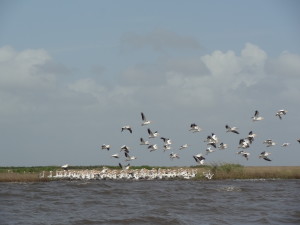We have much more to do and your continued support is needed now more than ever.
BP Connection? Oil Traces Found in Pelican Eggs Far from Gulf

Researchers for the state Department of Natural Resources have found evidence of petroleum compounds and the chemical used to clean up the oil in the eggs of pelicans nesting in Minnesota.
Scientists are looking for pollutants on a western Minnesota lake that is home to the largest colony of American White Pelicans in North America. About 34,000 adult pelicans will raise some 17,000 chicks this year on islands in Marsh Lake.
What’s most eye-catching is the high percentage of eggs showing petroleum:
Petroleum compounds were present in 90 percent of the first batch of eggs tested. Nearly 80 percent of the eggs contained the chemical dispersant used in the gulf.
“This high percentage really surprised me,” said Carroll Henderson, the DNR’s non-game Wildlife Program supervisor.
Henderson cautions that the results are still too preliminary to draw any conclusions as there are no tests of eggs before the spill to compare them to. But he said the results raise a lot of questions.
“While many more tests are needed, this is not good news,” says Doug Inkley, senior scientist with the National Wildlife Federation. “Instead of quickly breaking down, oil and dispersant could be entering the food chain, persisting and being passed on to the next generation.”
To be clear, we don’t know if the petroleum found in the pelican eggs is tied to the BP oil spill. However, the National Wildlife Federation continues to find pervasive oil in coastal Louisiana marshes in key wildlife habitat.






















